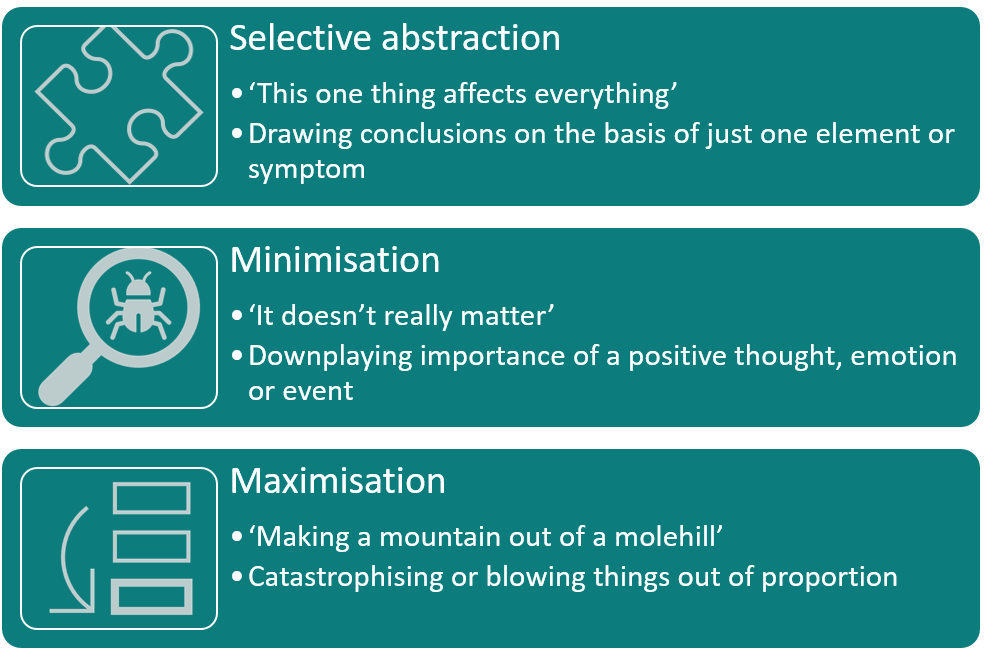Leading Libraries Series: Leading for Resilience
Mental resilience
Decoding unhelpful beliefs
We all recognise that one of the symptoms of mental stress is a tendency to fall into unhelpful belief patterns like 'no-one cares about this apart from me', 'I'm just not good enough at this' or 'I'm never going to be able to...'. As we said
in the 'Building mental resilience' segment, each of these unhelpful beliefs is a form of 'cognitive distortion' - a thought process that generally leads us away from the results we really want.
It can be scary to admit that you may fall prey to distorted thinking. You might be thinking, “there’s no way I am holding on to any blatantly false beliefs!”. While most people don’t suffer in their daily lives from these kinds of cognitive
distortions, it seems that no one can completely escape these distortions – especially in periods of stress or difficulty.
There is a list of the main types of distortions below but if you would like to see more examples of distortions, there is another good list by John M Grohal at Psychcentral.
So, once we have been aware that we have become caught in a distorted way of thinking, what can we actually do about that? Luckily there is a tried-and-tested way to decode and combat our cognitive distortions – by becoming aware of our negative
thinking, identifying which distortion is at play and replacing the distorted thought with one that is more realistic or positive. There are many different processes for doing this, from a variety of different sources such as Cognitive
Behaviour Therapy (CBT) and Neurolinguistic Programming (NLP). The simple worksheet on 'Record, Rationalise, Replace' will help you through one structure for reflecting on a negative thought pattern of your own.
Spotting cognitive distortions
There are many different lists of cognitive distortions but the main ones are captured in this diagram.


Brief descriptions of the main cognitive distortions
Selective abstraction
This distortion focuses on a single negative piece of information and excludes all the positive ones.
Minimisation
The ‘minimisation’ distortion acknowledges positive experiences but rejects them instead of embracing them.
Personalisation
As the name implies, this distortion involves taking everything personally or assigning blame to yourself without any logical reason to believe you are to blame.
Arbitrary inference
This refers to the tendency to make conclusions and predictions based on little to no evidence and holding them as gospel truth.
Magnification
Also known as the “Binocular Trick” for its stealthy skewing of your perspective, this distortion involves exaggerating the meaning, importance, or likelihood of things.
Overgeneralization
This distortion takes one instance or example and generalizes it to an overall pattern.
Record, rationalise, replace
One really simple way of decoding our negative thoughts is to identify the way in which the thought is distorted. The Reflective Exercise document linked in the 'Resource List' section of this module contains a template for a reflection box
to note down your learnings following the steps outlined below.
Record
Think back over the last few days and choose a recent experience which left you with negative thoughts and feelings.
Make a note of the situation, date and time.
Describe what happened in factual terms – not your interpretations!
Rationalise - Part 1
Now make a note of the negative thoughts and images that you experienced at the time.
Note how much you believed these thoughts on a scale from 1 (did not believe at all) to 10 (believed completely).
Rationalise - Part 2
For each thought that you list, note which cognitive distortions or faulty thinking styles you may be employing.
You can use one of the lists on the web or just identify the ‘thinking error’ yourself – the distortion may be unique to you!
Replace
Lastly, against each thought, note down one or two ‘replacement’ thoughts which are more realistic interpretations of the situation.
Pause for reflection: using record, rationalise and replace
Reflect on your experience of this tool to help you embed your learning.
- What did you notice about how you felt as you were noting down the initial thoughts?
- What did you learn from identifying the distortions that might have been at play in your thinking?
- Was finding replacement thoughts helpful? How might those thoughts have helped you react differently in the moment?
- How could you take this learning forward into the next difficult situation you face?
Continue to: Resource list





